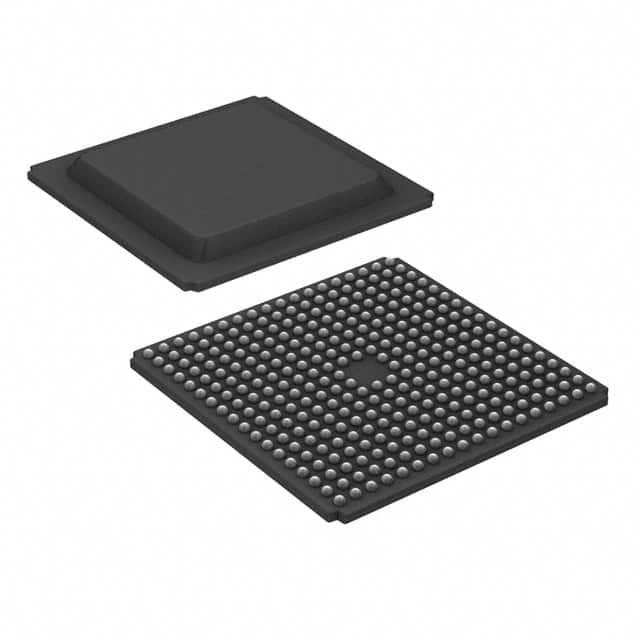XC3S1500-4FGG320I
Product Overview
Category
XC3S1500-4FGG320I belongs to the category of Field Programmable Gate Arrays (FPGAs).
Use
FPGAs are integrated circuits that can be programmed and reprogrammed to perform various digital functions. They are widely used in industries such as telecommunications, automotive, aerospace, and consumer electronics.
Characteristics
- High flexibility: FPGAs can be customized to perform specific tasks by programming their internal logic.
- Parallel processing: FPGAs can execute multiple operations simultaneously, making them suitable for high-performance computing applications.
- Reconfigurability: FPGAs can be reprogrammed multiple times, allowing for design changes and updates without replacing the hardware.
- Low power consumption: FPGAs offer efficient power utilization compared to traditional application-specific integrated circuits (ASICs).
- Scalability: FPGAs come in different sizes and configurations to meet varying application requirements.
Package and Quantity
XC3S1500-4FGG320I is available in a 320-pin Fine-Pitch Ball Grid Array (FBGA) package. The quantity may vary depending on the supplier or manufacturer.
Specifications
- FPGA Family: Spartan-3
- Logic Cells: 1,500
- System Gates: 2,000,000
- Block RAM: 576 Kb
- DSP Slices: 20
- I/O Pins: 320
- Operating Voltage: 1.2V
- Speed Grade: -4
- Temperature Range: Commercial (0°C to 85°C)
- RoHS Compliance: Yes
Detailed Pin Configuration
The detailed pin configuration of XC3S1500-4FGG320I can be found in the product datasheet provided by the manufacturer. It specifies the function and connectivity of each pin, enabling proper integration into the target system.
Functional Features
XC3S1500-4FGG320I offers several functional features, including: - Configurable logic blocks for implementing custom digital circuits. - Dedicated hardware multipliers and accumulators for efficient signal processing. - Programmable interconnect resources for establishing connections between different components. - On-chip memory blocks for storing data during operation. - Clock management resources for generating and distributing clock signals.
Advantages and Disadvantages
Advantages: - High flexibility and reconfigurability enable rapid prototyping and design iterations. - Parallel processing capability allows for high-performance computing tasks. - Lower power consumption compared to ASICs reduces energy costs. - Scalability provides options for different application requirements.
Disadvantages: - FPGAs can be more expensive than ASICs for large-scale production. - Designing complex FPGA systems requires specialized knowledge and expertise. - Limited availability of alternative models with similar specifications may restrict design choices.
Working Principles
FPGAs consist of an array of configurable logic blocks interconnected through programmable routing resources. The internal logic of the FPGA is programmed using a Hardware Description Language (HDL) such as VHDL or Verilog. Upon programming, the FPGA's configuration memory is loaded, defining the desired functionality of the circuit. During operation, input signals are processed by the configured logic blocks, and the output is generated accordingly.
Detailed Application Field Plans
XC3S1500-4FGG320I finds applications in various fields, including: - Telecommunications: Used in base stations, routers, and network switches for signal processing and protocol handling. - Automotive: Employed in advanced driver-assistance systems (ADAS), engine control units (ECUs), and infotainment systems. - Aerospace: Utilized in satellite communication systems, avionics, and flight control systems. - Consumer Electronics: Integrated into high-definition televisions, gaming consoles, and audio/video processing devices.
Detailed and Complete Alternative Models
- XC3S1000-4FGG320I: A lower-capacity variant of the same Spartan-3 FPGA family.
- XC3S2000-4FGG320I: A higher-capacity variant with double the logic cells and system gates.
- XC3S4000-4FGG320I: An even higher-capacity variant suitable for more complex applications.
These alternative models provide options for different project requirements, allowing designers to choose the most suitable FPGA based on their specific needs.
In conclusion, XC3S1500-4FGG320I is a versatile FPGA belonging to the Spartan-3 family. Its high flexibility, parallel processing capability, and reconfigurability make it suitable for various applications across different industries. While FPGAs require specialized knowledge and may have limitations in terms of availability of alternative models, they offer significant advantages in terms of customization, performance, and power efficiency.
Lista 10 Vanliga frågor och svar relaterade till tillämpningen av XC3S1500-4FGG320I i tekniska lösningar
Sure! Here are 10 common questions and answers related to the application of XC3S1500-4FGG320I in technical solutions:
Question: What is XC3S1500-4FGG320I?
Answer: XC3S1500-4FGG320I is a field-programmable gate array (FPGA) manufactured by Xilinx. It is part of the Spartan-3 family and has 1,536 logic cells.Question: What are some typical applications for XC3S1500-4FGG320I?
Answer: XC3S1500-4FGG320I can be used in various applications such as digital signal processing, embedded systems, telecommunications, industrial automation, and more.Question: What is the maximum operating frequency of XC3S1500-4FGG320I?
Answer: The maximum operating frequency of XC3S1500-4FGG320I depends on the specific design and implementation, but it can typically reach frequencies up to several hundred megahertz.Question: How much logic can XC3S1500-4FGG320I accommodate?
Answer: XC3S1500-4FGG320I has 1,536 logic cells, which can be used to implement various combinational and sequential logic functions.Question: Can XC3S1500-4FGG320I interface with external devices?
Answer: Yes, XC3S1500-4FGG320I supports various I/O standards and can interface with external devices such as sensors, memory modules, communication interfaces, and more.Question: What development tools are available for programming XC3S1500-4FGG320I?
Answer: Xilinx provides software tools like Vivado and ISE Design Suite for designing, simulating, and programming XC3S1500-4FGG320I.Question: Can XC3S1500-4FGG320I be reprogrammed after deployment?
Answer: Yes, XC3S1500-4FGG320I is a field-programmable device, which means it can be reprogrammed even after it has been deployed in a system.Question: What are the power requirements for XC3S1500-4FGG320I?
Answer: XC3S1500-4FGG320I typically operates at a voltage of 1.2V and requires additional power supplies for I/O banks and other peripherals.Question: Are there any temperature limitations for XC3S1500-4FGG320I?
Answer: XC3S1500-4FGG320I has an operating temperature range of -40°C to +100°C, making it suitable for a wide range of environments.Question: Can XC3S1500-4FGG320I be used in safety-critical applications?
Answer: XC3S1500-4FGG320I can be used in safety-critical applications, but additional measures such as redundancy and fault-tolerant design should be considered to ensure reliability.
Please note that these answers are general and may vary depending on specific design requirements and implementation details.


